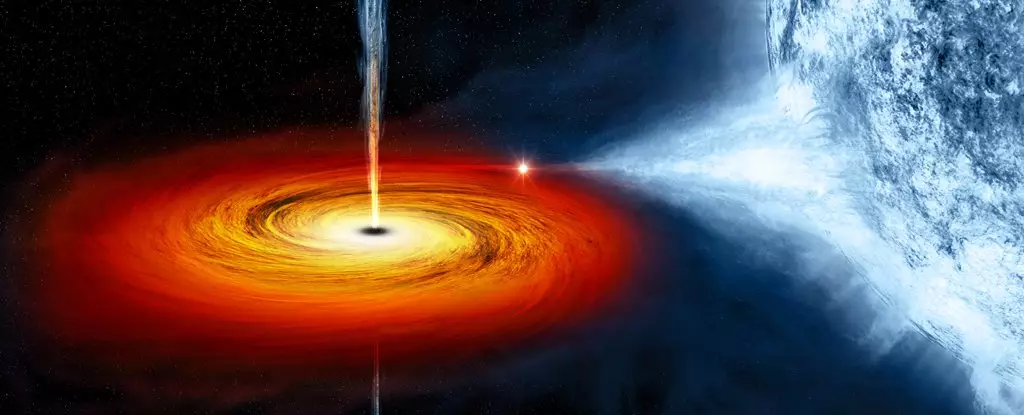For decades, astrophysicists have identified the most potent sources of gamma rays in the universe as originating from supermassive black holes, particularly those found in distant quasars. However, a groundbreaking study has reevaluated this notion, presenting evidence that some of the highest-energy gamma rays originate from a much closer and less-renowned object: the microquasar V4641 Sagittarii. Located approximately 20,000 light-years away in the constellation Sagittarius, this black hole system has revealed surprising characteristics that challenge existing theories about cosmic radiation sources.
At the heart of V4641 Sagittarii is a black hole with a mass roughly six times that of our Sun, which actively consumes material from a nearby giant star, approximately three solar masses in weight. This interaction plays out like an intricate cosmic ballet, propelling extraordinarily energetic gamma rays into space. The recent observations from the High-Altitude Water Cherenkov (HAWC) observatory have indicated that photons emitted from this microquasar exhibit energies reaching up to 200 teraelectronvolts (TeV). To contextualize this staggering figure, it represents a level of energy 200 trillion times that of visible light—a revelation that demands a reassessment of the dynamics at play within microquasars.
Traditionally, it was believed that microquasars like V4641 Sagittarii would emit lower-energy gamma rays, on the order of tens of gigaelectronvolts. Sabrina Casanova from the Institute of Nuclear Physics Polish Academy of Sciences captures this sentiment, emphasizing that previous findings had established a distinct energy gulf between gamma rays from microquasars and those from their more massive counterparts, the quasars. The surprising data emerging from the HAWC observatory, however, indicates that V4641 Sagittarii dispenses gamma rays with energies far exceeding those anticipated, bridging the gap previously thought unbreachable in the realm of cosmic radiation.
The mechanics behind the generation of these high-energy gamma rays have been likened to a cosmic particle accelerator. As the black hole in V4641 Sagittarii accretes material from its companion star, kinetic and gravitational forces come into play, creating conditions that ignite the production of gamma rays. The HAWC observatory, strategically stationed on the flanks of the extinct Sierra Negra volcano in Mexico, plays a pivotal role in this discovery. The facility is designed to detect particles with extraordinarily high energies. The observational technology, which includes 300 tanks filled with purified water, captures Cherenkov radiation—an optical phenomenon analogous to a sonic boom that illuminates high-energy interactions.
The HAWC observatory’s operational capacity to observe 15 percent of the sky at any one time allows it to map out cosmic radiation across two-thirds of the sky every 24 hours. Physicist Xiaojie Wang, while conducting a thorough review of HAWC’s sky maps, identified an unexpected gamma-ray emission from a region relatively distant from our galactic plane. His pursuit of this anomaly led to the discovery of V4641 Sagittarii as an intense source of ultra-high-energy gamma rays—an identification that had previously eluded astronomers.
The identification of V4641 Sagittarii as a source of gamma rays comparable to those from more massive quasars is a momentous finding for astronomers. It expands our understanding of cosmic behavior and the scaling of processes that lead to high-energy emissions. While quasars operate over timescales of millions of years, microquasars like V4641 Sagittarii allow us to observe these processes occurring on the order of days, effectively serving as ‘natural simulators.’
Examining the emissions from V4641 Sagittarii not only enhances our grasp of gamma-ray physics but also potentially enables researchers to refine existing models of accretion and radiation processes associated with black holes. This newfound knowledge may serve as a cornerstone for future observational campaigns, reshaping our approach to studying microquasars and their enigmatic nature as miniature versions of the quasar phenomenon.
As we delve deeper into the cosmos, findings like those regarding V4641 Sagittarii highlight the complexities and unexpected phenomena that define our universe. The continued collaboration between observatories and improved technological advancements promises to unveil further secrets, challenging our understanding of how black holes interact with their environments. The study of high-energy gamma rays will likely continue to evolve, revealing more about the intricate workings of our universe and reshaping the narratives we construct surrounding cosmic events.

